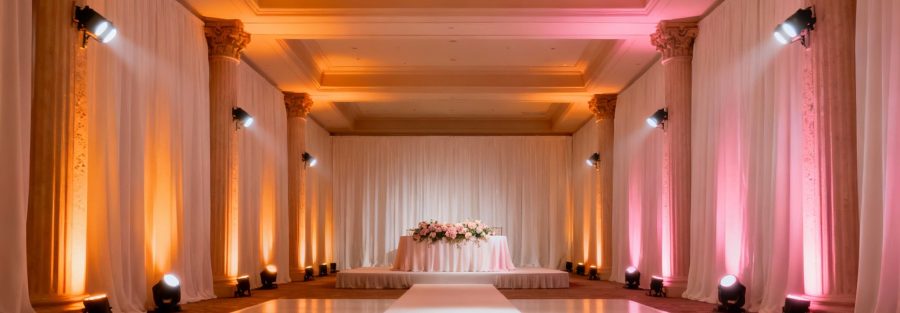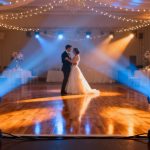Ever walked into a wedding reception and just felt… wow? That instant feeling of magic and romance, where the whole room seems to glow? That's the power of uplighting.
Think of it as the secret weapon in wedding decor. These are simply light fixtures placed on the floor, aimed upwards to shoot beams of colored light up the walls, columns, or other cool architectural features of your venue. It's a surprisingly simple concept that completely transforms a space.
What Are Uplights and Why Your Venue Needs Them
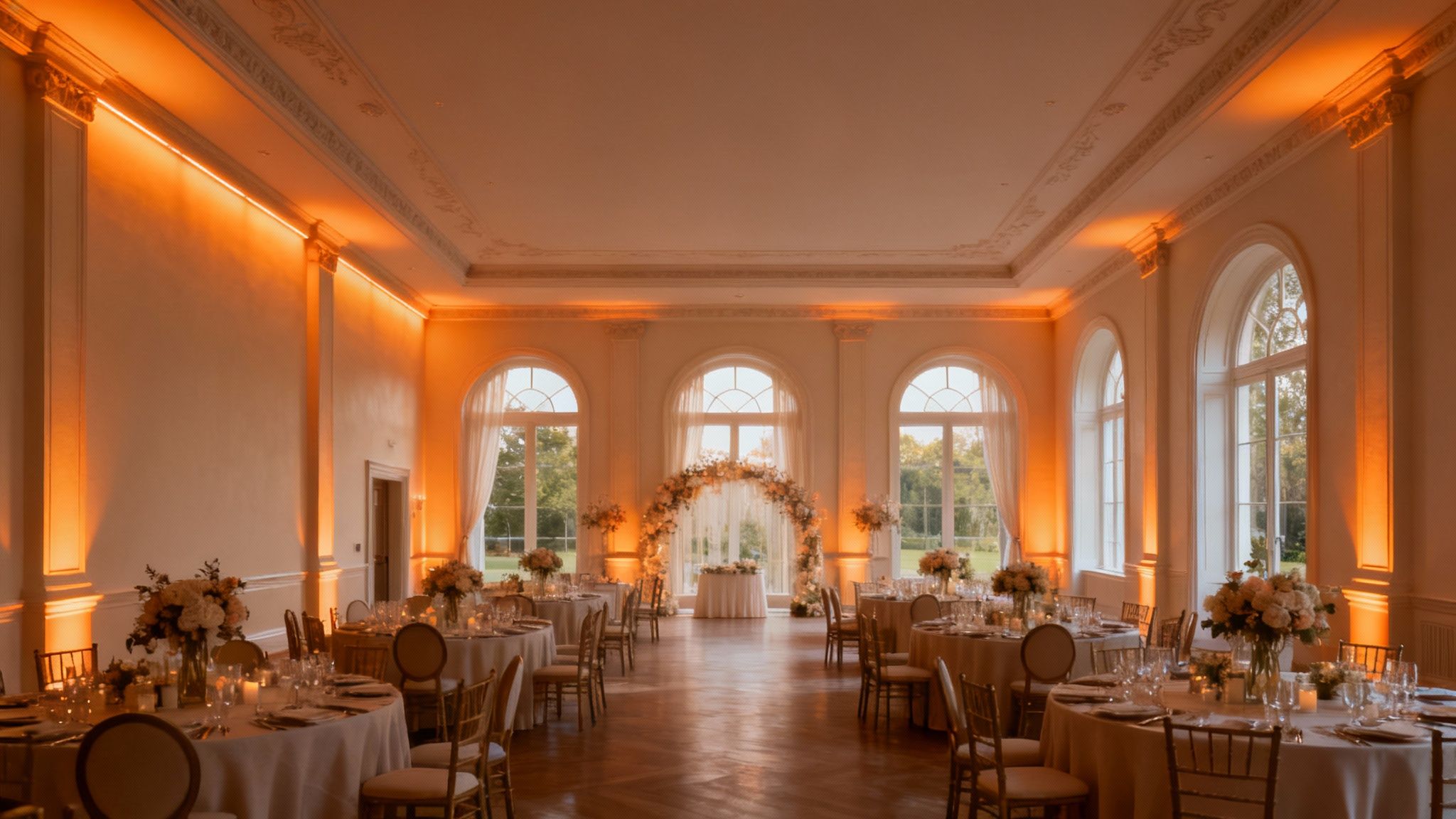
Let's be honest, most reception halls, when empty and lit by standard overhead lights, can look a little… plain. The walls are just walls. But with uplighting, you're essentially painting with light. You can wash those blank canvases with color, warmth, and emotion, making the entire room feel more intimate, grand, and perfectly styled to your wedding theme.
It’s the difference between a room and an experience. We dive a bit deeper into the fundamentals in our guide that asks, what is uplighting at weddings?
Here's a snapshot of what uplighting can do for your wedding reception.
Quick Guide to Uplighting Benefits
| Benefit | How It Elevates Your Wedding |
|---|---|
| Atmosphere Creation | Instantly sets a romantic, energetic, or elegant mood. |
| Venue Transformation | Makes a standard room look like a high-end, custom space. |
| Photo Enhancement | Adds depth and vibrancy, making your wedding photos pop. |
| Architectural Highlighting | Draws attention to beautiful columns, arches, and ceilings. |
| Theme Cohesion | Ties your color palette together across the entire room. |
As you can see, it's about much more than just adding a bit of color; it's about crafting an unforgettable environment for you and your guests.
Create Atmosphere and Ambiance
The number one job of uplights for a wedding reception is to set the vibe. A soft, warm amber glow during dinner can make a huge room feel cozy and romantic. It's perfect for those heartfelt toasts.
Then, when it’s time to party, the lights can switch to a vibrant blue, purple, or magenta. This instantly signals a shift in energy and gets everyone excited to hit the dance floor. You're in control of the room's mood from start to finish.
Uplighting is more than just decoration; it's an experience. It directs your guests' eyes to beautiful features, hides less attractive ones, and makes the entire room feel more intentional and professionally designed.
It's no wonder this has become a non-negotiable for so many couples. The demand for creative event lighting has exploded because it delivers that "wow" factor everyone is looking for.
Highlight Key Features and Elevate Decor
Beyond creating an overall mood, uplighting is fantastic for putting a spotlight on the details you've spent so much time planning. It's all about strategic placement.
Use uplights to draw everyone's attention to:
- Architectural Details: Got stunning pillars, dramatic archways, or a beautifully textured brick wall? Light them up!
- Focal Points: Give your head table, cake display, or grand entrance the dramatic frame it deserves.
- Floral Arrangements: Placing a small light at the base of a large floral centerpiece can make it look absolutely breathtaking.
You're essentially telling your guests, "Look at this beautiful thing!" without saying a word. It ensures your most important decor elements don't just blend into the background. For more inspiration on how to make your venue unforgettable, check out these more stunning outdoor wedding reception ideas.
Choosing the Perfect Uplighting Colors
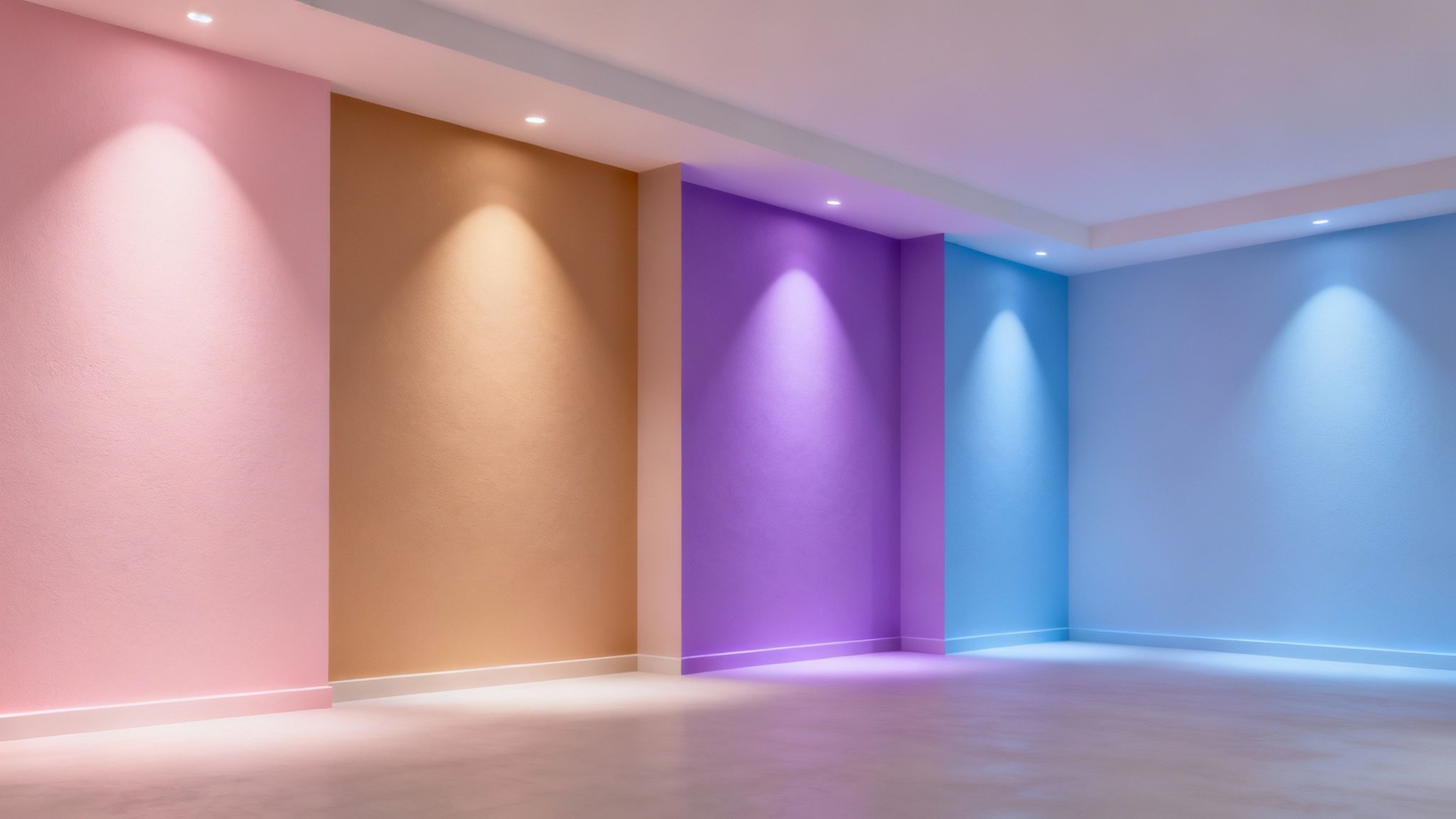
Okay, this is where the real fun begins. Picking the color of your uplights for a wedding reception goes way beyond just matching your flowers or tablecloths. You’re literally painting with light, setting the entire emotional tone for the biggest party of your life.
Think of it this way: color is mood. It's the silent soundtrack playing in the background, telling your guests how to feel.
A soft, warm amber glow, for example, can make a massive ballroom feel as cozy and intimate as a candlelit dinner. It encourages conversation and creates a wonderfully romantic backdrop. But switch that to a vibrant magenta, and suddenly the room is buzzing with energy, practically begging people to hit the dance floor. You’re not just picking a pretty color; you’re crafting an experience.
Setting the Mood with Color
The psychology behind color is a powerful tool. The right shade can calm, energize, or wrap the room in romance. When you get intentional with your color choice, it elevates everything.
Here are a few popular choices I've seen work wonders and the kind of vibe they create:
- Amber or Warm White: These are the classics for a reason. They mimic a natural, candlelit glow that’s incredibly flattering in photos and just feels warm and inviting. It’s an elegant, can’t-go-wrong choice that complements almost any decor.
- Blush Pink: If you're going for that soft, fairytale feeling, blush pink is your best friend. It casts a dreamy, almost ethereal light that feels both modern and hopelessly romantic.
- Blue: A deep, royal blue instantly adds a layer of sophistication. It creates a cool, dramatic atmosphere that feels grand and a little bit luxe.
- Purple or Magenta: Want a party? These are your go-to colors. They bring an electric energy to the room and are the perfect choice when it's time to transition from dinner to dancing.
Matching Colors to Your Venue and Theme
Beyond the mood you want to set, you have to think about the canvas you’re working with—your venue. The color of the walls plays a huge role. A beautiful blush pink will look true and vibrant on a white wall, but it might get lost or look muddy against dark wood paneling. If you can, always ask your lighting pro to do a quick color test at the venue.
Your lighting should also play nice with your other decor, like your florals and linens, pulling everything together into one cohesive vision. For a really detailed look at how different colors work together, check out this fantastic guide on the best uplighting colors for a wedding. The goal is a beautiful, layered look, not a color competition.
Pro Tip: Don't feel like you have to commit to just one color for the whole night! The most dynamic lighting designs evolve. I love starting with a soft, romantic amber for the cocktail hour and dinner, then programming a switch to a high-energy purple or blue once the dancing gets started.
This ability to completely transform a space is exactly why professional lighting has become such a wedding essential. The demand for these kinds of personalized, luxurious experiences is driving major growth in the wedding industry—the global market for decorations is projected to jump from USD 8.31 billion to USD 15.16 billion. You can discover more about this market growth and see how custom touches like lighting are at the heart of this trend.
How Many Uplights Do You Actually Need?
Trying to nail down the exact number of uplights for your reception can feel a little like guesswork, but it’s more art than science. There’s no secret formula, because the right number really comes down to two things: the size of your room and the kind of vibe you're going for.
Are you picturing a few elegant accents here and there? Or are you dreaming of washing the entire space in a vibrant, uniform color? Each look requires a different approach and, of course, a different number of lights.
A Simple Rule for Spacing
If you’re not sure where to begin, a great rule of thumb is to place one uplight every 10 to 15 feet along the walls. This spacing is the sweet spot—it’s just right to create a continuous flow of color without leaving any weird, dark gaps between the beams of light.
So, if you’re looking at a 100-foot wall, you'd probably want somewhere between 7 and 10 lights to make it look polished and complete. It's a simple calculation that gives you a solid starting point.
Remember, the goal isn't just to throw light everywhere. It’s about creating a thoughtful design. It’s always better to use fewer lights in strategic, high-impact spots than to scatter too many around randomly. That can just make the room feel busy or washed out.
Prioritizing Key Areas
Now, let's talk strategy, especially if you're working with a budget. You don't have to line every single wall with lights to make a statement. The trick is to focus on the areas that will get the most attention and show up in all your photos.
Think about the main focal points of your reception:
- The Head Table: This is a must. Placing two to four lights behind the newlyweds' table creates a beautiful frame and makes it the clear center of attention.
- The Cake Display: A single, perfectly aimed uplight can transform your cake from a dessert into a stunning work of art.
- Architectural Features: Got cool pillars, gorgeous old brick, or dramatic archways? Use a light to play them up and add character to the room.
- The Grand Entrance: Lighting the doorway sets the mood from the moment your guests walk in, giving them that "wow" factor right away.
By concentrating on these high-impact zones, you can create a truly luxurious feel with a surprisingly small number of uplights for your wedding reception. It’s all about making smart choices that bring your vision to life. If you want to get into the nitty-gritty, you can explore more about modern LED uplighting solutions and see all the custom looks they can create.
Where to Place Uplights for Maximum Impact
So, you've got a rough idea of how many lights you'll need. The next big question is: where do you actually put them? This is where the magic really happens. Strategic placement is the secret sauce that separates a so-so lighting job from a professional, breathtaking design. It’s how you make your reception space feel bigger, more intimate, or just plain dramatic.
Think of it this way: anyone can switch on a lamp, but a designer knows exactly where to place it to make a room sing. The same goes for uplights for a wedding reception. A few simple placement tricks can completely transform your venue.
Wall Washing for Ambiance
One of the most popular and effective techniques out there is wall washing. It’s pretty much what it sounds like: you place uplights close to a wall and aim them up to create a wide, even column of light that stretches from the floor to the ceiling. When you space several lights along a long wall, their beams blend together, "washing" the entire surface in a smooth, continuous glow.
This method is fantastic for setting the overall mood of the room. It instantly makes the space feel taller and more expansive while adding a ton of color and dimension. You’re not just throwing up random spots of light; you’re creating a gorgeous, cohesive backdrop for the whole night.
Spotlighting for Drama
While wall washing sets the vibe for the entire room, spotlighting is all about creating those "wow" moments. This technique uses a single, tight beam of light to grab everyone's attention and point it toward a specific detail. It's your way of telling your guests, "Hey, look over here—this is important and beautiful!"
You can use spotlighting to:
- Highlight the Wedding Cake: This turns your cake from just a dessert into a show-stopping centerpiece.
- Accentuate Floral Arrangements: Make those stunning (and pricey!) florals really pop, especially when the main lights are dimmed.
- Frame the Head Table: This ensures all eyes are on the happy couple, right where they should be.
This handy infographic breaks down the two main approaches, showing how they create totally different effects.
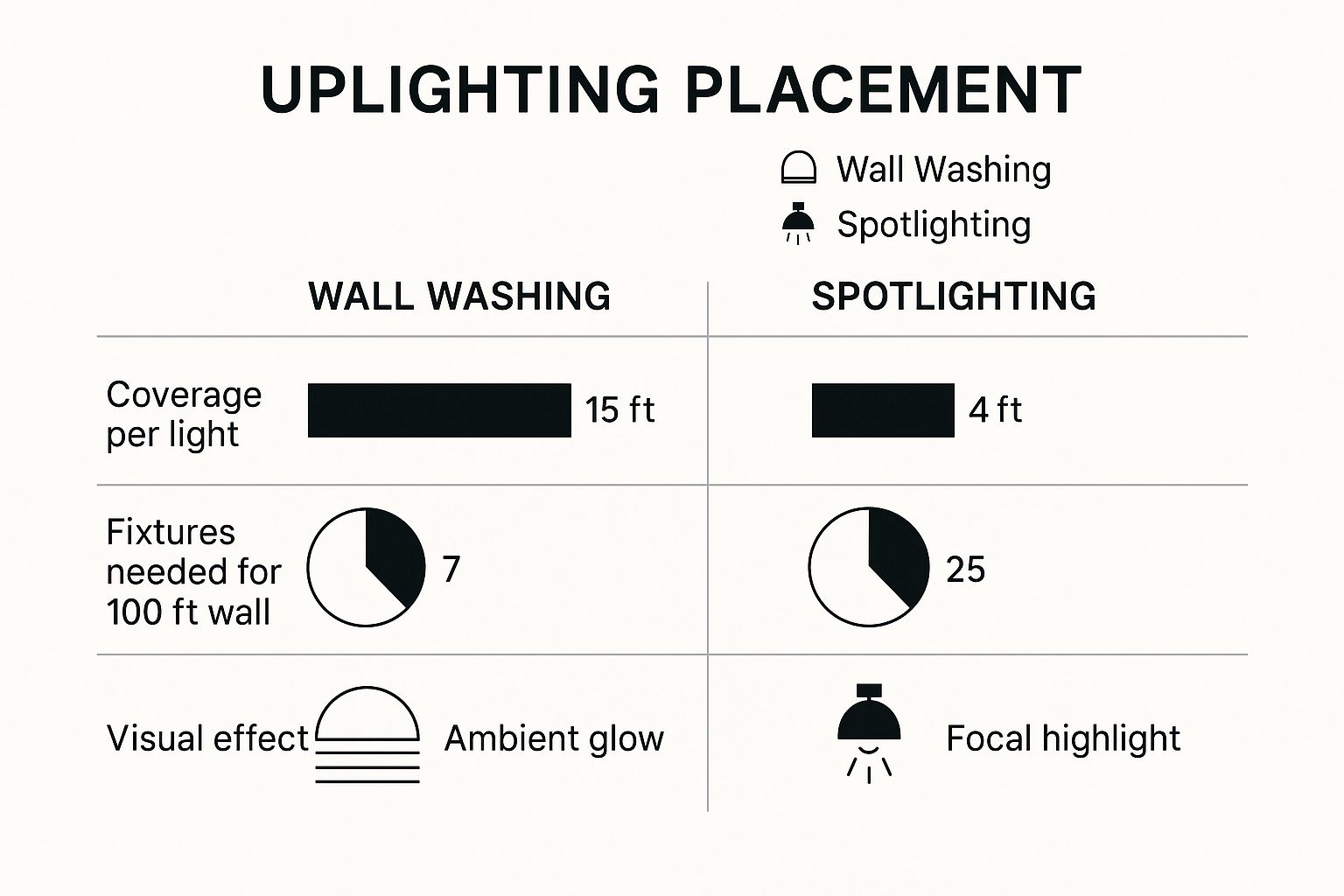
The best lighting designs almost always use a mix of both. You can create a warm, inviting foundation with wall washing and then layer in spotlights to make sure all the key elements you spent so much time planning get their moment in the limelight.
Common Uplighting Placement Techniques
Discover where to place your lights to achieve different visual effects at your reception.
| Placement Technique | Best For | The Final Look |
|---|---|---|
| Wall Washing | Creating overall ambiance, making a room feel larger, and setting a color theme. | A soft, even glow that covers entire walls, providing a beautiful backdrop. |
| Spotlighting | Highlighting key features like the cake, head table, or floral centerpieces. | A dramatic, focused beam of light that draws attention to specific elements. |
| Column Lighting | Accentuating architectural details like pillars, columns, or archways. | Makes structural elements stand out, adding depth and elegance to the room. |
| Perimeter Lighting | Defining the entire event space and creating a cohesive feel. | A continuous line of light that outlines the room, making it feel intentional and complete. |
| Dance Floor Lighting | Creating a fun, high-energy atmosphere for dancing. | Dynamic, often color-changing lights focused on the dance floor to get the party started. |
By understanding a few of these basic placement ideas, you can have a much more productive conversation with your lighting vendor to map out a design that makes your reception feel truly magical.
Sometimes, seeing is believing. For some serious inspiration, check out these amazing uplighting before-and-after transformations to see just how powerfully a few well-placed lights can redefine a space.
DIY Uplighting vs Hiring a Pro
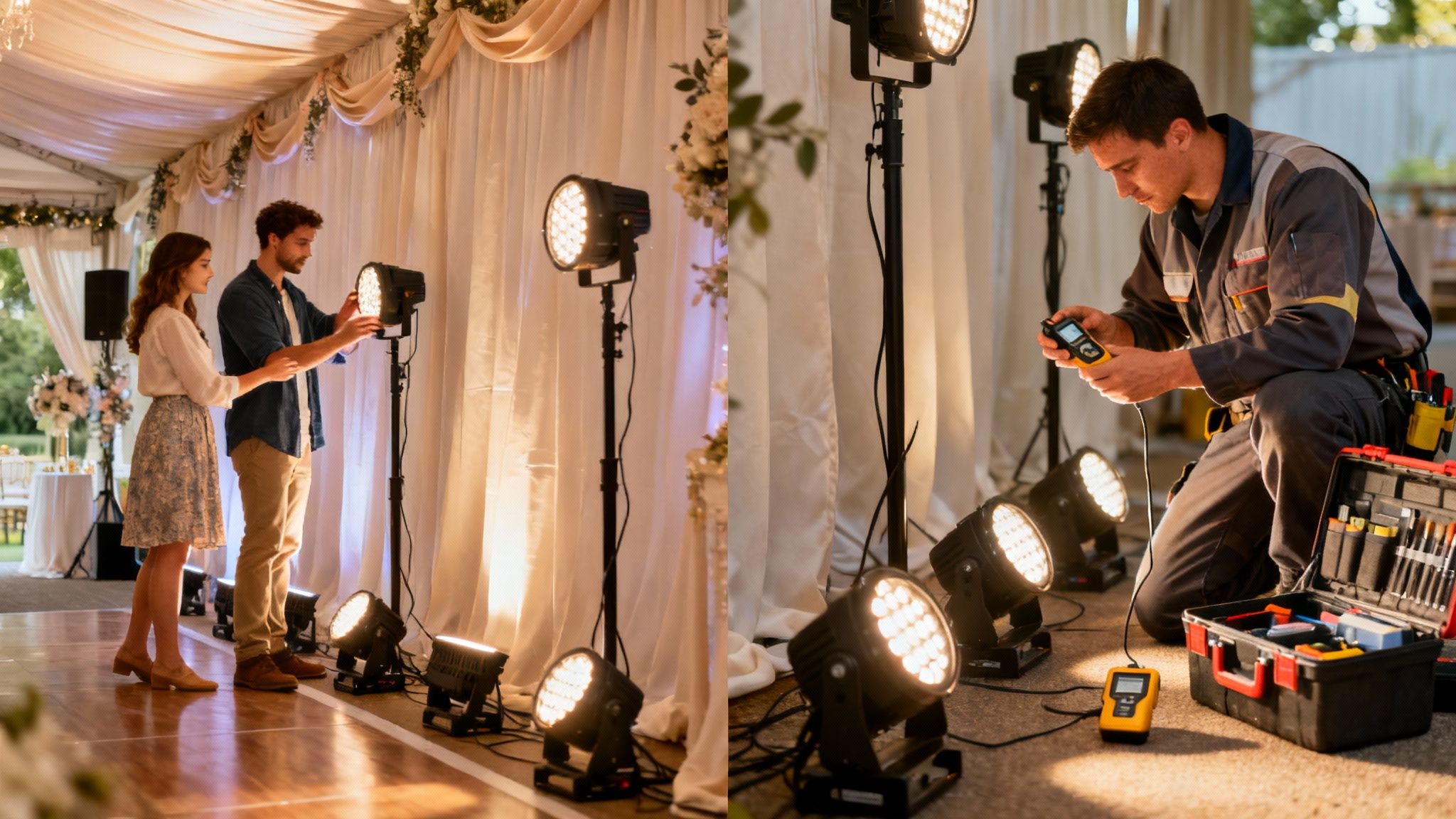
This is one of the biggest questions couples face when it comes to lighting: should you rent the gear and do it yourself, or bring in a pro? It really boils down to a classic trade-off—saving some money versus saving yourself a potential headache on your big day. Let’s get real about what each path actually looks like.
The DIY option is tempting, mostly because of the price tag. You can find plenty of companies online that will ship a box of wireless, battery-powered uplights right to you. It puts you in the driver's seat, but that also means you’re the one responsible for everything. Setup, troubleshooting, and packing it all up at the end of an already exhausting night? That's all on you.
The DIY Uplighting Route
Going DIY means you're not just the happy couple; you're also the lighting tech for the evening. You’ll need to make sure every light is fully juiced up, figure out the best spots to place them, and get all the colors programmed just right. While there’s a certain satisfaction in doing it yourself, it’s one more major to-do item on a day that’s already jam-packed.
If you’re leaning this way, here’s a quick reality check:
- Battery Life: Make sure the lights can go for at least 8-10 hours. Your reception is long, and you don’t want the lights dying before the last dance.
- Ease of Use: You’re not a lighting expert. Look for simple, remote-controlled units so you’re not fumbling with complicated settings.
- Reliability: Dig into those reviews. The last thing you need is cheap gear failing halfway through your party.
The big win with DIY is saving money, no question. But you're paying with your time and energy instead. Be honest with yourself: will you or a trusted friend really have the bandwidth to manage all this on the wedding day?
Hiring a Lighting Professional
Hiring a pro is the "set it and forget it" dream. A real lighting designer doesn't just bring better equipment; they bring an artistic eye and the technical know-how to make your venue look absolutely incredible. They handle literally everything—designing a custom plan, setting it all up, running the show, and tearing it all down when you’re off on your honeymoon.
This is the path to total peace of mind. You just show up and enjoy the beautiful atmosphere without thinking twice about a single battery or cable. With couples increasingly seeking personalized and unique experiences, it’s no surprise the global wedding services market is projected to grow at a CAGR of 12.7%. You can discover more about this wedding market trend to see how expert services are becoming the norm.
Thinking about the technical side of a professional LED lighting installation can give you a good idea of the expertise involved. When you're ready to see what the pros can do, checking out professional event lighting rentals is the perfect place to start.
Your Wedding Uplighting Questions, Answered
Alright, so the idea of uplighting has you hooked, but a few questions are still bouncing around in your head. That’s completely normal. Getting the lighting just right for your big day involves a lot of little details you might not think of at first.
This is your go-to spot for those final, nagging questions. We've rounded up the most common things couples ask us, so you can lock in your plans and stop stressing. Let's make sure your reception lighting is nothing short of spectacular.
How Much Does Wedding Uplighting Usually Cost?
This is always the million-dollar question, isn't it? The honest-to-goodness answer is: it really depends. The price for uplights at a wedding reception can swing quite a bit based on where you live, how many lights you need, and if you're going DIY or hiring a pro.
As a ballpark figure, you can probably expect to rent lights for somewhere between $20 to $50 per fixture. But remember, when you hire a professional lighting company, you're getting a whole lot more than just the equipment. Their packages usually include the creative design process, programming the exact colors you want, setting everything up before a single guest arrives, and taking it all down at the end of the night.
Our best advice? Chat with a few local vendors and get detailed quotes. It’s the only way to compare what you're actually getting for your money and find the perfect fit for your vision and budget.
Are Wireless Uplights Better Than Wired Ones?
For a wedding? Oh, yeah. In almost every case, wireless, battery-powered uplights are the way to go. Their biggest superpower is flexibility—you can stick them literally anywhere without worrying about finding a plug.
This means you get the perfect look without a web of ugly extension cords and gaffer tape crisscrossing the floor. Trust me, the last thing you want is a tripping hazard for your friends and family on their way to the dance floor!
The one thing you absolutely must check is the battery life. Make sure the lights can last your entire party, which is usually at least 6 to 8 hours. While old-school wired lights will stay on forever, the hassle of hiding cords and their placement limitations just don't jive with the clean, elegant look most couples are after.
Does Uplighting Work for a Daytime Reception?
Uplighting definitely has its most "wow" moments after the sun goes down, when the colors can really pop and wash over the walls. If your reception is during the day in a room full of sunny windows, the effect is going to be much more subtle.
But that doesn’t mean you should skip it! Even in a bright room, uplights can add a beautiful splash of color and help define important spots.
Think of daytime uplighting as an accent, not a total room transformation. A few well-placed lights behind your head table, at the base of your cake display, or framing the entrance can add a really elegant, intentional pop of your wedding colors.
As the afternoon fades into evening, you'll get a lovely transition. The lights you set up earlier will start to glow more brightly, and the whole atmosphere of the room will shift right along with them.
Can I Use Uplighting for an Outdoor or Tented Wedding?
You absolutely can, and you absolutely should! Uplighting can be downright magical in outdoor and tented settings. Inside a tent, you can aim the lights up the support poles and along the fabric walls, making the entire ceiling radiate with color. It creates this breathtaking, immersive glow that feels incredibly grand and romantic.
If you're in a more open-air venue, use the lights to play with the landscape itself. You can light up gorgeous old trees, a rustic stone wall, or the cool architecture of a nearby building. This trick does more than just add color—it creates a sense of depth and dimension, so your space doesn't just feel like a big dark field after sunset. Just make sure whoever is providing the lights uses fixtures rated for outdoor use, so they're safe and weather-resistant.
Ready to create an atmosphere your guests will be talking about for years? The experts at 1021 Events live and breathe this stuff. We specialize in professional uplighting and full event production to make your vision a reality. Let us handle the details so you can soak up every moment. Visit us at 1021 Events to learn more and get a personalized quote!

